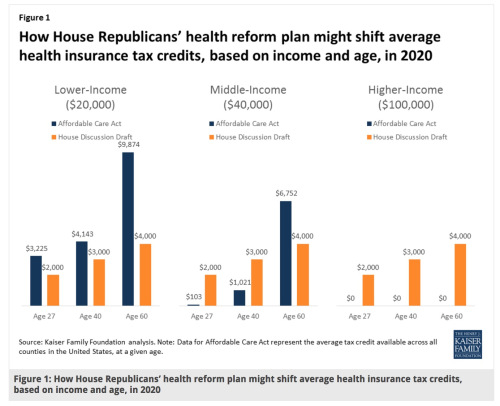By James Kwak After the dangerous clown show that has been the Trump White House, it’s comforting to return to some good, old-fashioned conservative policymaking: bashing the poor to cut taxes on the rich. I’m talking, of course, about the Republican plan to repeal and replace Obamacare. Health care financing can sometimes seem like a complicated topic. Adverse selection, risk adjustment, blah blah blah. But it’s easy to understand the American Health Care Act or, as it is sure to be known, Trumpcare. In the medium term, financing policies have little effect on the price of health care. At most we can hope to “bend the [long-term] cost curve.” So health care policy essentially comes down to a single question: Who pays? Let’s start with the most fundamental element of the Republican
Topics:
James Kwak considers the following as important: Commentary, health care, Health Insurance, Obamacare, syndication, Trumpcare
This could be interesting, too:
Dean Baker writes Health insurance killing: Economics does have something to say
Nick Falvo writes Homelessness planning during COVID
Nick Falvo writes Report finds insufficient daytime options for people experiencing homelessness
Bill Haskell writes Some Angry Bear Updates
By James Kwak
After the dangerous clown show that has been the Trump White House, it’s comforting to return to some good, old-fashioned conservative policymaking: bashing the poor to cut taxes on the rich. I’m talking, of course, about the Republican plan to repeal and replace Obamacare.
Health care financing can sometimes seem like a complicated topic. Adverse selection, risk adjustment, blah blah blah. But it’s easy to understand the American Health Care Act or, as it is sure to be known, Trumpcare. In the medium term, financing policies have little effect on the price of health care. At most we can hope to “bend the [long-term] cost curve.” So health care policy essentially comes down to a single question: Who pays?
Let’s start with the most fundamental element of the Republican plan, the one most near and dear to Paul Ryan’s heart, the principle that has kept the conservative coalition unified since 1994: cutting taxes on the rich. Trumpcare will eliminate virtually all of the taxes that Obamacare introduced to expand health care coverage, including the Medicare surcharges that only apply to high earners: 0.9% on earned income and 3.9% on investment income. That in itself is a 16% cut in taxes on investments for a class of people who make lots of money from investments. Health savings accounts will increase the tax breaks available to high-income families. The “Cadillac tax,” which would have affected people with generous health plans, will be pushed back until 2025 (in a transparent bid to improve the bill’s scoring for reconciliation purposes), with the expectation that it will be repealed at some point in the future.
With less revenue coming in to pay for health care, the federal government will pay for less health care. Trumpcare reduces government spending in two main ways. First, people who buy insurance in the exchanges will have to pay more, both in premiums and out of pocket. Obamacare’s income-based subsidies will be replaced by age-based tax credits. The net effect will be to increase the price of coverage for lower-income people and decrease it for higher-income people:

(The chart is from the Kaiser Family Foundation and is based on slightly different numbers from the proposed bill, but the basic principles remain the same. The final bill does phase out tax credits beginning at $150,000 in family income.)
Because Trumpcare eliminates the individual mandate, more healthy people are likely to opt out of coverage. This will increase the average actuarial cost of people buying individual plans, which will push up premiums—a transfer from sick people to healthy people. Trumpcare also repeals the Obamacare limits on cost sharing (deductibles, copayments, etc.) for low-income families. So in addition to paying more to buy health insurance in the first place, poor people will have to pay more when they actually try to use their health insurance.
The second major way that Trumpcare pays for its tax cuts is by reducing federal spending on Medicaid. The plan reduces the amount the federal government pays for Medicaid expansion (a central component of Obamacare), which at best will simply shift costs to the state level, and at worst (and more likely) will cause more states to opt out of Medicaid expansion altogether. In addition, Trumpcare achieves the long-held conservative dream of converting Medicaid into a block grant program, which means that Republican state governments will be able to use the money in ways that are only tangentially related to providing health care for poor people. (Temporary Assistance for Needy Families block grant money, for example, is routinely used to support abstinence programs or premarital counseling services aimed at getting couples to marry.)
There are more details, but the basic outlines of the plan are simple: Cut taxes on the rich, cut spending on the poor, and expose more families to rising health care costs. The thing is, we’re talking about health care here. People will need the same amount of health care no matter what Congress does. If the government pays less for health care, poor people will have to pay more. If they can afford it, Trumpcare is effectively the same as a tax on the poor. If they can’t afford it, it’s even worse. This is as naked an example of class warfare as you’ll see today.
